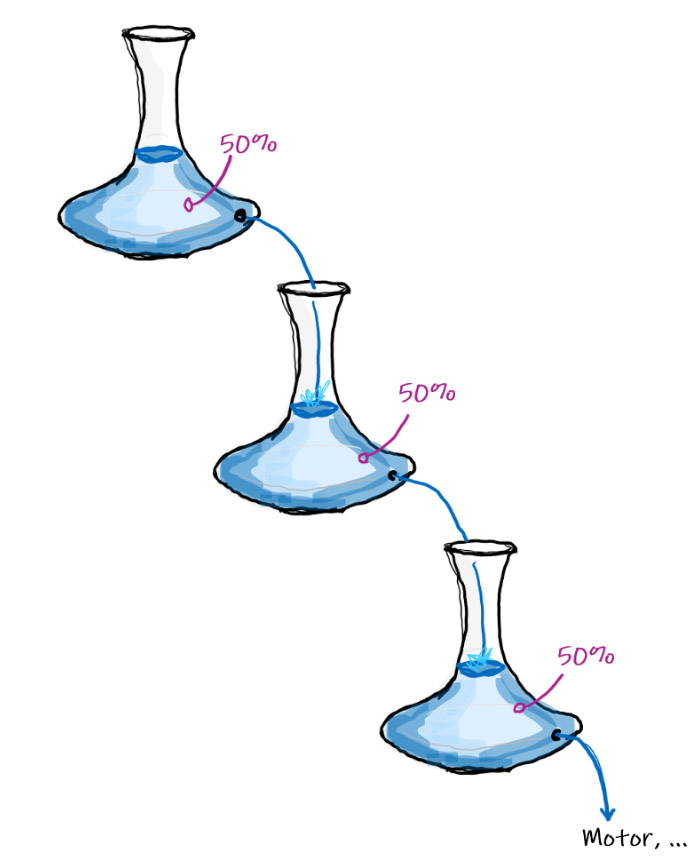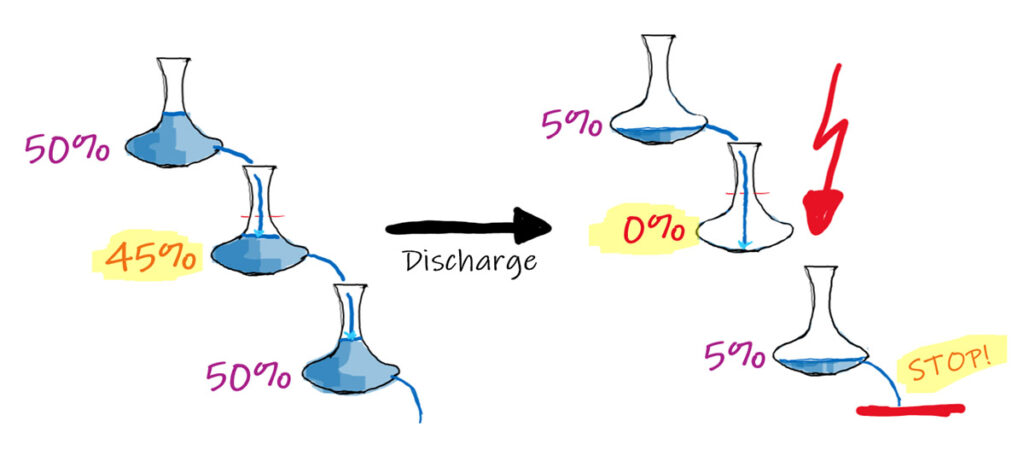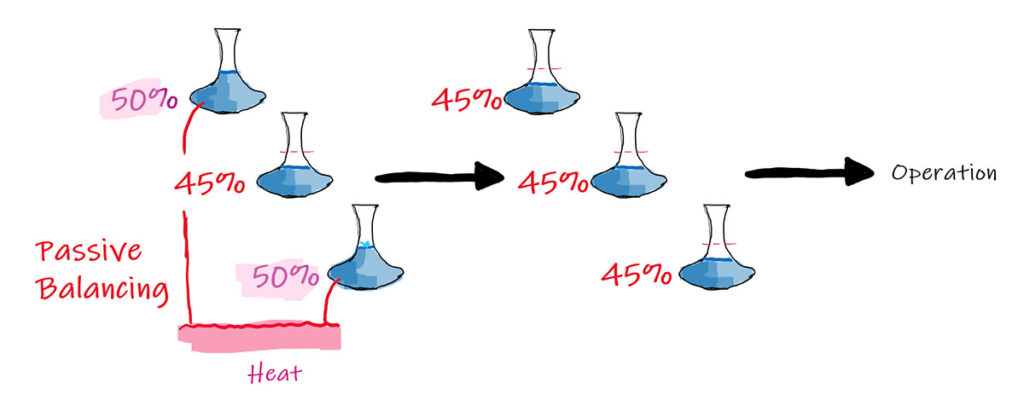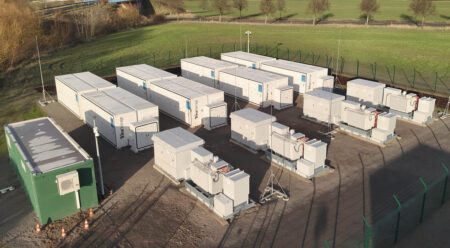
The Battery Cycle #5: Balancing inhomogeneities, or why a LFP bus sometimes stops
Below is a new contribution from Claudius Jehle, CEO of volytica diagnostics GmbH. It’s the fifth of a series of knowledge articles on topics around Li-Ion Batteries.
What is a Sudden Depletion Event? Why is balancing between cells crucial? How to preserve SOC in the best possible way? Why is it instrumental to highlight the aspect of proper balancing already during tendering?
Today, we will explain the concept of homogeneity or symmetry, and the mitigation, balancing. Learn the underlying technicalities, the impact on operation and optimization strategies.
System topology
A “battery” is not one cell, although we might want to reduce it to that in every day conversation. Ideally, it should behave like it, but as always, things are more complex in reality.
In a battery system, dozens or typically hundreds of single cells are connected in series (that is, the plus of one is connected to the minus of the next and so on), forming a string. Each additional cell raises the total system voltage. As “power” is “voltage times current”, doubling the voltage (by putting cells in series) cuts the necessary current half, and as cable diameters is mainly determined by maximal current, raising system voltage by putting cells in series basically helps to reduce cable size, weight and costs. As simple as that.1 If we want more capacity, we add whole strings in parallel.
But by this simple “trick” new problems occur: disbalance, inhomogeneity, inaccessible energy and the necessity for balancing.
Inhomogeneity: A Thought Experiment
If we depart from a system where all cells are the same, we run into serious problems that we will explain here. As usual, we start with simple analogies that we (almost) perfectly suitable for every day conversations. Consider a single string system (works perfectly the same with multistring systems) and figure it – attention: metaphor – as a cascade of the already introduced glasses, discharging into one another.
Would you agree that as long there is no leak, the amount of liquid going in on the top completely passes unchanged through each and every single cell?

So, if now all have exactly the same capacity (SOH, later articles), and all start at the same filling height (voltage), then all of them have the same starting content (SOC). If current flows through the cascade, each cell in this perfect example is being filled/emptied by the exact same amount of liquid. If you keep discharging them, they all approach 0% SOC simultaneously2. Vice versa, if you keep filling them up, they all will be 100% full at the same time.

In this ideal world we need no balancing, as there is no inhomogeneity whatsoever. Of course, this is not the case in the real world – there are many imperfections. Let’s take a closer look: leave the above thought experiment as it is, but for what reason ever, 1 of 100 cells has a slightly lower SOC, only 45% instead of 50%. The average SOC is still c. 50%3, but as the cascade is being discharged, clearly the “lemon cell” will be empty before the others. This will be detected by the battery management system’s safety features and the complete flow will be interrupted to not deep-discharge and potentially damage the lemon – while 99 cells still have c. 5% SOC. Think of the lost potential! There is still 5% in the system, but it is inaccessible.
Suddenly Empty: If this system emergency shutdown happens at full speed, the result is what we call a sudden depletion event (SDE) – a vehicle that until seconds or minutes ago displayed a substantial and unproblematic (system-average!) SOC, might suddenly stop and the SOC display drop close to 0%, to protect the lowest cell from damage.
By the way: If you followed all articles so far, you should have a feeling why especially LFP is prone to that effect.
Balancing is key!
What is balancing now doing? In very simple terms: a balancing system has to take care that all cells have the same SOC (filling content), ideally at all times. The simplest, but also the most common, approach is often called passive balancing, and it seems wasteful: a master logic determines the SOC of the “lemon” (or lemons) and discharges all other cells using a bypass circuit4. Yes, in above’s example, a passive balancing system would start leaking up to 5% from all the 99 good cells, almost “bleeding” them out5. This charge is lost.

There are also active balancing systems in place, which are way more sophisticated and themselves prone to failures due to their complexity, and also more invest intensive. The result is also that all 100 cells would end up at the same SOC, but by actively shifting excess charge from the 99 others to back up the lemon, no charge is lost in the process.
When does balancing happen?
In large and very active stationary systems active balancing is becoming more and more common. However, the simplicity and robustness of passive systems still make them the means of choice in mobile applications. So, to keep it simple, the following is true only for passive systems.
As said, a balancing system must first determine the SOC of every cell. As you learned in article #3, this is particularly difficult for electronics especially in dynamic “foamy” situations, i.e. during operation or charging. So the balancing system will want relaxed idle periods, and is even more happy if the average SOC is very high, as the “glass shape” of most chemistries allows for an accurate voltage-to-SOC-conversion when almost full. The longer the idling, the more disbalance can be “heated away” by leaking.
Now you understand why OEMs recommend an extended idling phase directly after charging to 100%? Exactly: Idling at high SOC facilitates balancing – the longer the better.
Reasons for inhomogeneity
We have not answered the questions why at all the cells don’t behave the same. We brought the example where one cell is slightly emptier than the others (i.e. SOC). The reality is very complex, with many interactions. To highlight one very mean, because self-enforcing, reason: due to manufacturing imperfections, uneven cooling/heating flows, welding issues, electronics imperfections etc. pp. some cells degrade slightly faster than others – really only slightly – leading to a spread in capacity (i.e. SOH, not SOC). When continuously charged and discharged, the differences in SOH will lead to the SOCs of all cells starting to diverge in a manner comparable to the first thought example. The mean part is: a cell that is slightly smaller than the others experiences more current per capacity (C-rate), even increasing degradation stress. Also, it is likely to have a slightly increased resistance, leading to increased temperature. Also, the SOC window is affected. A “pre-lemon cell” is thus likely to continue a spiralling-down. Irreversibly.
While the balancing system is always trying to level out SOC, it cannot affect the irreversible SOH spread. This can be mitigated by a balancing system for some months or years, at least the operator will not directly feel the ongoing process. But at one point in time, balancing times would take so long to completely level everything out, that operation would be severely affected. Or, if kept still too short, the risk for SDEs would significantly increase.
Recommendations
It is instrumental to highlight the aspect of proper balancing already during tendering. Then it is relevant to adhere to the balancing recommendations of the OEMs, and monitor both adherence and effectiveness. It is worth requesting information on the internal inhomogeneity, reversible and irreversible, and the effectiveness of balancing of each asset, as all of this has huge impact on daily operation and longterm value.
Take home messages
- Battery systems are complex – they consist of hundreds of single cells. If they not all perform in perfect harmony, one cannot extract all seemingly available energy from it.
- In worst-case situations, disbalanced systems can suddenly appear to “self-deplete” in “Sudden Depletion Events”, leading to prompt and potentially dangerous en-route standstills
- Balancing needs time and particular conditions to excel – most often it happens during extended idle phases after a full charge
- The reasons for disbalance and inhomogeneity are very complex, and a pre-disbalance can lead to self-enforcing internal degradation, aggravating the problem
- It is advisable to adhere to OEM recommendations, but also to independently keep track of the inhomogeneity, reversible and irreversible, and the effectiveness of balancing
Footnotes:
1 Many readers might object – the power electronics perform better at higher voltages, too! Correct, but mainly due to comparable reasons, i.e. current density.
2 Note that for the moment we think of the process to be extremely quick, i.e. that the resistance of the cells in extremely low, and again the same for each and every cell. This is of course not the case in reality.
3 Actually, it is 49.95% (1×45% + 99×50%), but never is a SOC given with 2 decimals
4 In fact, every cell with SOC > lemon is discharged using small heating resistors.
5 In fact, this process is sometimes called “bleeding”, the circuit using “bleeding resistors”
Originally published on Sustainable Bus


